Article and all photos by Joe Mock, BaseballParks.com
All rights reserved
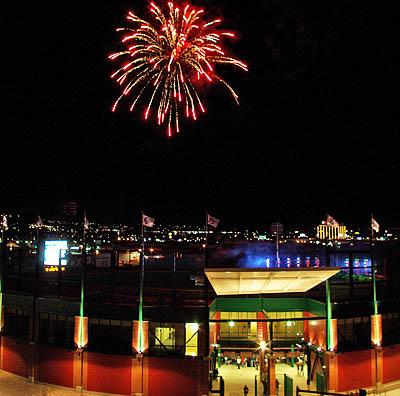 |
In some respects, the new ballpark in Reno, Nevada is the one that should exist in Las Vegas. Interesting, entertaining color scheme. Proximity to casinos and hotels. Fascinating, unique lighting in right field. Extremely cool 7th-inning-stretch feature.
| Ballpark Stats |
 |
| Team: The Reno Aces of the Triple-A Pacific Coast League |
| First game: April 17, 2009 — an 11-1 win over Salt Lake |
| Capacity: 9,100, of which 6,980 are fixed seats |
| Architect: HNTB |
| Construction: Devcon Construction, Inc. |
| Price: $50 million |
| Home dugout: Third base side |
| Field points: north by northeast |
| Playing surface: mixture of bluegrass and rye |
| Betcha didn’t know: While ballpark standards call for Triple-A facilities to accommodate at least 10,000 fans, the Aces received permission to have a capacity of only 9,100 |
Instead, the fun, new ballpark is in northern Nevada rather than southern, meaning Vegas is left with its uninspiring facility.
All the better for Reno. It’s a more affordable place to come and visit — and try your luck at the gaming tables — anyway.
The Tucson Sidewinders of the Pacific Coast League moved to Reno for 2009, taking on the appropriate moniker of “Aces.” They immediately made themselves at home in the lovely new park. With a quaint location along the Truckee River just a couple of blocks from Reno’s version of The Strip, the locals are embracing the new digs.
There was pro baseball already in town prior to the move by the Sidewinders. A market this large (population: 215,000, with 377,000 in its metro area) wouldn’t be without the national pastime. However, the Reno Silver Sox weren’t in an affiliated Minor League. Instead, they played in the independent Golden League, holding their home games at Peccole Park, which is the University of Nevada’s home field.
There certainly wasn’t room for both franchises to operate in Reno, so the Golden League vamoosed out of town when Triple-A baseball arrived on the scene. Ironically, the Silver Sox franchise moved to Tucson, which is the market abandoned by the PCL team that relocated to Reno.
Was Aces Ballpark an upgrade for local baseball fans? Is day different from night? You bet that the new stadium is a significantly better home for pro baseball than the University’s field. There’s nothing wrong with Peccole, as it is a perfectly adequate college facility, with a lovely view of the snow-capped mountains south of town. But it has almost none of the creature comforts of a modern stadium like the Ace’s new home.
But compared to other affiliated Minor League parks, especially in Triple-A, how does Aces Ballpark stack up? Come on along for a look at its site, its exterior, its architectural design and fan amenities.
The Setting
I never saw the site of Aces Ballpark prior to construction, so I don’t know what was there previously. However, the location seems logical to me.
That’s because it checks a lot of the correct boxes. Is there adequate parking? Yes, there’s an enormous parking garage directly across the street from the main entrance behind home plate (very handy for taking photos like the one at the top of this page), and more garages within a couple of blocks. Is there a body of water nearby? Yes, the Truckee River snakes beyond the right field perimeter fence — and provides great scenery if you want to take pictures of the park from its far bank (below left). Is it near other activities in town? Yes, Reno’s famous “Arch” (seen in the Ballpark Stats box above) is just a couple of blocks away, and lots of casino action can be found on that street. In addition, the mammoth National Bowling Stadium is just two blocks away. In case you like the sound of trains, are there tracks nearby? Yes, in fact the concourse beyond left field is fairly narrow because such tracks are just a few feet away (below right). Is one of the best Italian restaurants at which I’ve ever dined close by? Yes, La Famiglia is less than two blocks from the park’s main gate.
  |
OK, that last point isn’t usually on my checklist, but that restaurant has some of the best Italian food I’ve ever eaten.
There will be more food choices and retail establishments one day (below left), as the “Freight House District” — a very ambitious project directly adjacent to the ballpark — is currently under construction.
And I am fully on board with the need for ballparks to face (roughly) northeast to minimize the sun being in the players’ eyes. In this instance, though, the most gorgeous mountains are southwest of downtown Reno, so you can’t catch a glimpse of them from the main seating bowl. You can see some hills, and from right field you can look beyond the grandstand to see the neon of the casinos in the distance (below right), but you don’t get to see the really tall, snow-covered mountains.
 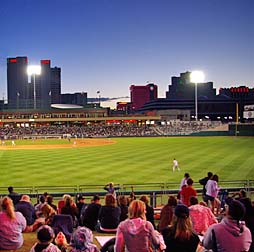 |
The site itself was not without its challenges, to say the least. Joe Diesko, Principal at HNTB, the architectural firm that designed the park, summed up the negative aspects of the location as having, “the complexities one finds in any older urban site (such as) major utility relocations and with some environmental remediation required to remove contaminated soil left over from many years of industrial and warehouse use.” The extra work was certainly worthwhile.
The Exterior
The exterior of Aces Ballpark isn’t stunning in the manner of Parkview Field in Fort Wayne or Huntington Park in Columbus. It does have an extremely appealing color scheme, both inside and out, and that is one of the ballpark’s strengths.
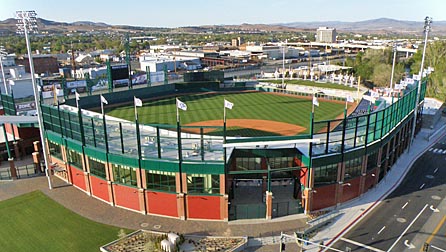 |
The contrast of red-painted block along the bottom of the exterior wall, glass in the middle and green metal above it really works well. When you add brick columns rising to separate each of the “panels,” you have an attractive look indeed — and one that is quite unique in the baseball world.
Adding to this novel approach are screens all along the roof line. I suspect these are 90% functional (to cut down the number of foul balls landing in the street, plus it’s possible it reduces swirling winds) and 10% aesthetic.
There are two main entryways at the park. The one behind third base (below left), which the team sometimes refers to as the “rotunda entry,” is quite close to where the commercial development will be, so there should be shops and restaurants close to this soon. Its most noteworthy feature, of course, is the huge white circle over the gates. Balancing this over the home-plate entry (below right) is a huge white rectangle.
Both of these entryways incorporate areas you could call plazas. The one behind home is mostly on the outside of the stadium, with stairs and nice landscaping. The plaza on the third-base side is much larger and mostly inside the gates.
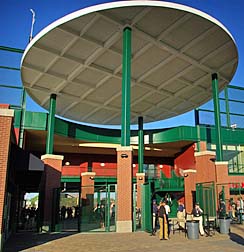 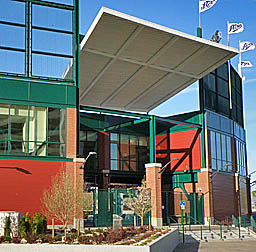 |
I’m not 100% sure what the large white geometric shapes are trying to accomplish, aside from the obvious aspects of providing covering over their plazas and breaking up the monotony of the roofline.
There is another, smaller entry beyond first base very near where Kuenzli Street (one way heading west) and 2nd Street (one way heading east) split. This side of the ballpark isn’t as noteworthy, except that instead of block, there are metal fences through which pedestrians on the street can see a little bit of the field inside.
You can’t really see any of the exterior of the outfield because of the railroad tracks beyond left field and the brush along the river near right field.
The Design
There is a lot to like in HNTB’s architectural design, and a couple of things not to like — although to be fair, the most egregious elements were insisted on by the team.
As has become customary in newer Minor League parks, the main concourse at the rear of the lower-level seats is “open” (nothing blocks your view of the field as you walk around) for the most part, plus the floor of the upper level forms the ceiling over that main concourse. This gives you a lot of headroom, which makes for an even more “open” feel than usual (below). That’s good.
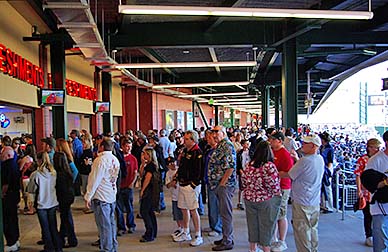 |
It is a 360-degree concourse, so you can walk all the way around the field. This is also a good thing, although you can’t see the action at all points of your walk (e.g., you walk behind the batter’s eye in center field), and the walkway is a little on the narrow side in left field because of the proximity of the ReTrak railroad tracks behind you. This area under the scoreboard in left, though, provides a great vantage point from which to watch the game (below left), plus there’s a drink rail there on which you can set your food or beer. And even though it’s narrow through here, I think it’s a positive thing that you can walk all the way around, because there is a lot to experience in right field.
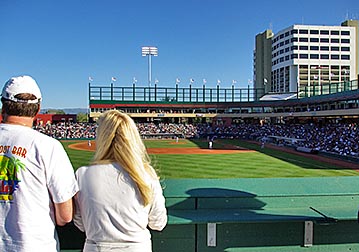 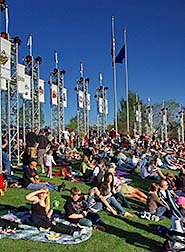 |
Without a doubt, right field (above right) is one of the highlights of the design of Aces Ballpark. There is a lot happening here, not the least of which is some wild lighting effects that not only keep the folks on the berm from sitting in the dark during night games, its various colors also tie into other actions (on the video screen, auxiliary boards and other aspects of the entertainment). For instance, these lights twinkle when the Aces score. I don’t believe I’ve seen anything like this at other parks. Give credit to Stuart Katzoff, President and Managing Partner of the Aces, for the lighting concept here.
Also in right field is a man-made hill that provides the grass berm and behind it is a bar and various food kiosks. And beyond those features is an even taller hill dubbed “Baseball Mountain” that provides quite a panoramic view of the park (below left). Note the roofless bar is in the foreground). Again, all of this is good, and gives Aces Ballpark a much nicer outfield area than the new Triple-A park in Gwinnett County, Georgia, plus it has the 360-degree concourse that Columbus lacks.
Interestingly, a number of boulders had to be moved from the river side of the site during construction. Making lemonade from these lemons, the boulders were used to help create this “mountain.” HNTB’s Diesko said that he thinks this hill “picks up a lot of what’s great about the Reno-Tahoe area. It reminds you that you are in the beautiful Sierra Mountains alongside the legendary Truckee River.” He added that the hill serves the functional purposes of “keeping the crowd noise in and more importantly making the ballpark feel bigger.” Both are good ideas.
 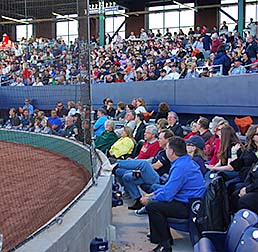  |
However, in the main seating bowl, there is an “us versus them” section that I’m not fond of. Many new parks physically separate some really expensive seats from the hoi polloi in the regular seating sections. That’s the case here in Reno.
These “dugout suite” seats (above center) are actually below field level, and include quite a buffet for the ticket-holders. The vantage point is pretty impressive (above right), I have to admit, but I don’t like how this chops up the seating bowl and creates such obvious class segregation. The price for 15 tickets in this area for a single game, by the way, is $1,300.
I like the group areas that were incorporated into the lower level. The Coors Light Party Zone is near the left-field foul pole, and features chairs around tables that are angled toward the infield. Just beyond the fence in right-center field is the Bullpen Party Deck, which is actually closer to the outfielders than the right-field berm, because the bullpens are between the berm and outfield fence.
The panoramic shot on the left-hand side below gives you a pretty good sense of how the upper level relates to the lower seating bowl. This, though, leads me to the design aspects of the park that bother me the most.
 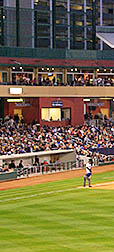 |
The “suite level” (as the team calls the upper deck) is certainly beautiful, and the 21 suites themselves are as nice as they come. On the far right-hand side of the upper level (i.e., behind third base) is the Plaza Overlook group area and, to its left in the picture, the Hall of Fame Club, a beautiful sit-down dining area that also features 88 outdoor seats.
Then from this Club all the way around to first base are the suites, all in an uninterrupted row. The lighter-colored area at the extreme left side of the upper deck in the photo above is, believe it or not, the press box. Was it really more important to have suites directly behind home plate than the press area? The team, not the architects, felt so.
But the design anomalies don’t end there. Perhaps to squeeze in even more suites, there are no radio booths near the press area on the upper level. Now, you’re probably thinking that this doesn’t much matter to the average fan attending a game here, but here’s the problem: with no areas for broadcast members of the press on the upper level, this forced the booths to be placed on the lower level, at the rear of the seating bowl (see the middle of the right-hand photo above). This, of course, blocks the view from the concourse, and interrupts the otherwise perfectly “open” concourse in the infield.
I know HNTB placed the press box on the lower level directly behind home plate at the parks they designed in Charleston, WV and Billings, MT, but in those instances, there was no upper deck — plus the entire area for the press was in the same place. The way it was done in Reno, though, isn’t good. I don’t like it aesthetically, and I certainly don’t like this functionally, as it separates the radio guys from the official scorer and the rest of the press by a ridiculous amount.
Apparently, some thought was given to adding a third level behind home plate to house a large press box, but the budget simply didn’t allow it.
The outfield dimensions are both a function of the altitude and the shape of the parcel of land on which the park was built. Because the field is 4,385 feet above sea level, fly balls travel about 7 or 8% farther than at sea level, so down the right-field line it’s 340 feet from home, right center is 386 and dead center is 410. Death valley, though, exists between right center and center, as the corner right in front of the Bullpen Party Deck is a stout 424 feet from home. The railroad tracks behind left field constrain the dimensions there, as that foul line is 338 feet long and the distance to left center is only 370. To compensate, the wall is taller here.
So the overall architectural design isn’t bad, but the illogical placement of the radio booths mars an otherwise excellent arrangement. Read on for what the game-day experience is like.